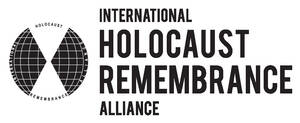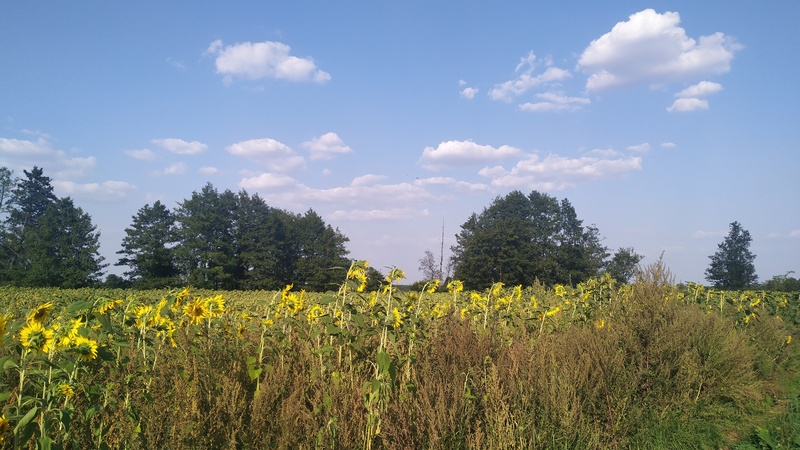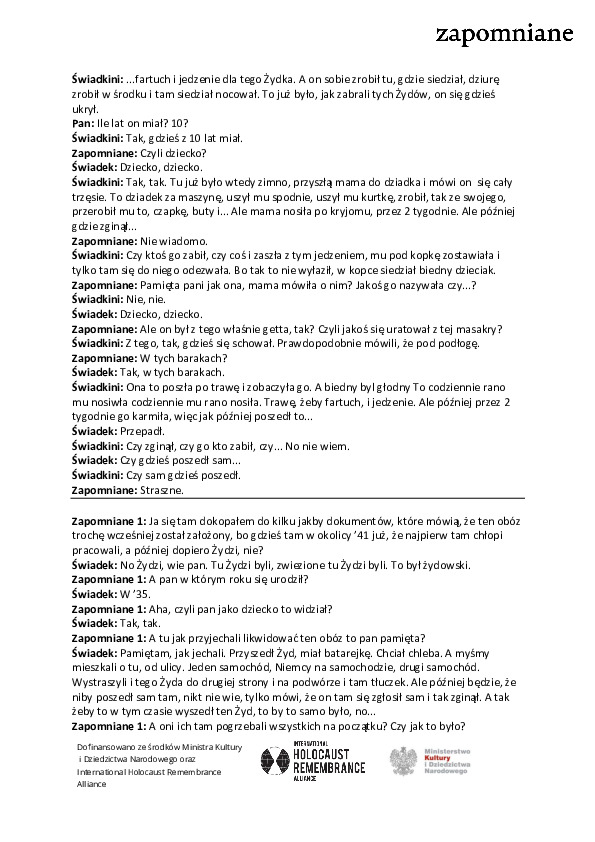Szczeglacin
Borough of Korczew , Siedlecki District, Mazowieckie VoivodshipType of place
Cultivated fieldInformation about the crime
A labour camp for Jews from eastern Mazovia operated in the Korczew borough in the Szczeglacin village from 1940 to 1942. The camp’s inmates did slave labour to regulate the Kołodziejka River under extremely difficult conditions. Jan Grabowski and Marta Woźniak, among others, described the history of the camp in their articles.
“The Germans established Julag, or Judenlager, a forced labour camp for Jews in Szczeglacin in 1940. Most of the Jews working in the camp came from the ghettos of the consolidated district of Sokołów-Węgrów (Sokołów – Węgrów), which was the immediate vicinity. Their worked on the regulation of the small river Kołodziejka, which flows into the Bug not far from there. The working conditions in the camp were terrible. At least one hundred Jews died of exhaustion or were killed by guard-torturers. They were buried in mass graves. None of the inhabitants of the surrounding villages today are able to pinpoint their exact location”. (Grabowski, 2021, https://jewish.pl/pl/2021/05/16/zapomniane-ofiary-mordu-w-szczeglacinie/)
Yet we were able to reach the inhabitants of the village who showed us the site of the camp and then the graves of the victims in the summer of 2022. A sunflower is currently growing on the site. The graves of the victims of the camp are supposed to be located on plot number 377.
“There were two long ditches and one that was half shorter. They buried the Jews in the long ones and the Jewish police in the short one. The Jewish police kept watch. People who lived close by peeped from the attic windows. They said that the Jewish police pushed people who did not want to go further. They must have thought that they would survive. They killed them, buried them and then they also killed the Jewish guards. There were women, children, everything”. (August, 2022)
Marta Woźniak points out that the camp’s prisoners were murdered with extreme cruelty:
“The Jewish workers from the Szczeglacin camp were murdered together with their families, and the manner of their killing could be described as a specific combination of the purest cold calculating and primitive bestiality. The Germans perfidiously organised the murder so that it was the Jews themselves who did almost all the work involved, except for the act of killing itself. According to some accounts, Jews dug their own graves, convinced that they were pits to store potatoes for the winter. It was Jewish workers who became gravediggers of their own wives and children, only to be covered with earth by Jewish policemen in the death pits just a moment later. The perfidy of the Nazis was also manifested in the fact that the whole action was carried out very quickly and “quietly” – probably on the morning of 22 October 1942. The Germans arrived in their cars at the camp, carried out its liquidation, shot in bursts into the pits filled with the bodies of the Jews, covered them with lime and earth and immediately left to Drohiczyn. “In the spring”, according to witnesses, probably in 1944, they returned to the site to exhume the remains in order to obliterate all traces”. (Woźniak, 2010)
Both Woźniak and Grabowski quote extensive eyewitness accounts of the massacre in Szczeglacin:
Piotr Szczepaniak: “I ran to see what was happening in the ghetto. Mieczysław Solich’s house was closest to the ghetto. I could see everything from this house. First the men dug pits, then the Germans brought the women and children there and ordered them to jump. And as they did not want to jump, they hit them with long clubs. Some jumped into the pit themselves to avoid the blows. When the pit was full, one of the Germans approached it with a machine gun and started shooting. Immediately afterwards, the pit became quiet. The men buried their wives and children. Right after that they had to dig pits for themselves and a small one in addition. When the pits were ready, the men were ordered to approach them and everything repeated in exactly the same way. There was one difference – this time the Jewish policemen were the gravediggers. Once the pits had been covered up, it was the policemen’s turn. They were told to approach the pits and it all happened again. The policemen were buried by Ukrainians who worked for the Germans. Right after that the German troops left. It was all over. All the ghetto buildings survived. Some people, myself included, used to go there to look for gold. I remember one day, actually at night, we went to the ghetto. Searching in the dark, I found some kind of trapdoor. When I opened it, it turned out that there was a storage compartment. I went in there and kept looking. I found a jewellery purse. That was my only loot. Shortly afterwards the ghetto burned down. The whole ghetto was surrounded by barbed wire about 2.5-3 meters high. There were probably five buildings there. One building was located outside the fence. Jewish policemen lived in it. The other buildings, four I think, were fenced. I don’t remember a kitchen there. I think the Jews cooked on trivets and in pots in the square”.
Ludwik Woźniak: “There were probably two barracks there. Some 30 metres away two round, deep pits were dug. The Jews walked from the barracks to the pits, one behind the other, at a distance of about a metre from each other. At the bottom stood a German with a truncheon, and another one on the other side. They had piles in their hands, thinner on one side and thicker on the other. When a Jew approached, bang! The German would hit him on the head with a stick and he would fall into a pit. They were beating them in turns. Bang! Bang! And down. Some jumped into the pit themselves to avoid being beaten. And they were jumping alive. When they had knocked everyone out, they covered both pits with something white; I saw it go up. I don’t know if it was chlorine or lime. First they shot into the pits with machine guns and covered them with this white powder and then covered them with earth. They did it very quickly and immediately got into the cars and left to Drohiczyn. I ran out of the barn and ran there. I thought I might find something left of these Jews. As a child, I was curious what’s going on there, I wondered if they are still alive. When I reached the site, the ground was still moving. There were some stinking rags, a cap, an overturned piece of stool. Some money, torn papers. They got in their cars and left, and that’s how it ended”. (Woźniak, 2021)
The people we met in 2022 also told us about what happened at the site of the camp after it was liquidated and its prisoners murdered. They also mentioned the search of the camp site for the mythical gold:
“- Did people go there after the war to look for something?
– Of course they did.
– Was there anything?
– They were rich Jews. […] There were two boys, one from my year, the other younger, and they were playing there with the sand. And they found gold. They held it in their hands and shouted: We have gold! We have gold!
– What was it specifically?
– Jewellery. […] After some time they came and took these bodies away, but did they take them all? When they opened [the graves], you couldn’t go out on the road. The stench was horrible, sweet Jesus!
One of our interviewees also shared the story of a ten-year-old boy who survived the massacre and hid in the fields for about two weeks:
“- Mother used to put on an apron and carry food for this Jew. He made a hole in the hay and hid there. It was after they took those Jews away.
– How old was he?
– Somewhere around 10. He was a child. My mother came to my grandfather and said he’s shaking all over. Grandpa sewed trousers and a jacket for him on the sewing machine. He tailored his cap and boots. She would take the food to him, leave it, have a word with him. He didn’t come out of there at all. He was sitting in the mound all the time, poor kid.
– Do you remember what your mum used to call him?
– No, no.
– He was from that camp, right? So he somehow managed to survive the massacre?
– He was hiding somewhere. People said he was probably hiding under the floor, in those barracks. Mum saw him, when she went to get the grass. He was poor, he was hungry, so every morning she would carry him food. I don’t know if he died, if someone killed him or if he went somewhere on his own…. Terrible. (August 2022)
Jan Grabowski concludes his article as follows:
“The site of this terrible crime is literally just outside the last buildings of the village. To my surprise, at least part of this area is now a cultivated field. Not even a trace of this tragedy remains today. No stone, no plaque, nothing. We do not even know whether the massacre took place at the end of October or at the end of November 1942. We do not know whether the Germans exhumed and burned some of the corpses before the end of the war or not. We pride ourselves on being a society that remembers its victims. But are we really? Don’t the eight hundred victims of the mass murder in Szczeglacin deserve even one sigh? Weren’t these victims also “our” victims? Don’t the victims deserve to be remembered no matter to what extent they are “ours”? (Grabowski, 2021, https://jewish.pl/pl/2021/05/16/zapomniane-ofiary-mordu-w-szczeglacinie/)
Transkrypcje
Contact and cooperation
We are still looking for information on the identity of the victims and the location of Jewish graves in Szczeglacin. If you know something more, write to us at the following address: fundacjazapomniane@gmail.com.
Bibliography
Grabowski J. Zapomniane ofiary mordu w Szczeglacinie [Forgotten victims of the Szczeglacin massacre], 16 May 2021, https://jewish.pl/pl/2021/05/16/zapomniane-ofiary-mordu-w-szczeglacinie/, accessed 9 November 2022.
Marta Woźniak “A ziemia się jeszcze ruszała…” Masakra Żydów w Szczeglacinie w relacjach świadków [“And the earth was still moving…” The massacre of Jews in Szczeglacin in the accounts of witnesses.] Holocaust Studies and Materials, Warsaw, 30 December 2010.
Marta Woźniak “A ziemia się jeszcze ruszała…” Obozy pracy przymusowej dla Żydów w Cerkwisku i Szczeglacinie Master’s thesis on cultural studies – cultural knowledge under the supervision of Jacek Leociak, Ph.D., Institute of Literary Research of the Polish Academy of Sciences, Warsaw 2012.
Recording of the Zapomniane Foundation (audio file), name: Witold S. born in 1935 and Anna S., topic and key words: Jewish labour camp in Szczeglacin, interviewed by Agnieszka Nieradko and Michał Kowalski, 28 August 2022.
We have collected the materials about this village thanks to the funding provided by the International Holocaust Remembrance Alliance as part of the project “The rural Holocaust. Collecting and safeguarding the never recorded testimonies 100 forgotten Jewish graves 2021-2022”. The materials for this website were developed, digitized and made available as part of the project “Development of a digital archive of Jewish war graves outside the extermination camps and educational use of archive resources” thanks to funding from the Minister of Culture and National Heritage from the Cultural Promotion Fund.

 Zdjęcie współczesne Szczeglacin
Zdjęcie współczesne Szczeglacin Szczeglacin transkrypcja nagrania
Szczeglacin transkrypcja nagrania